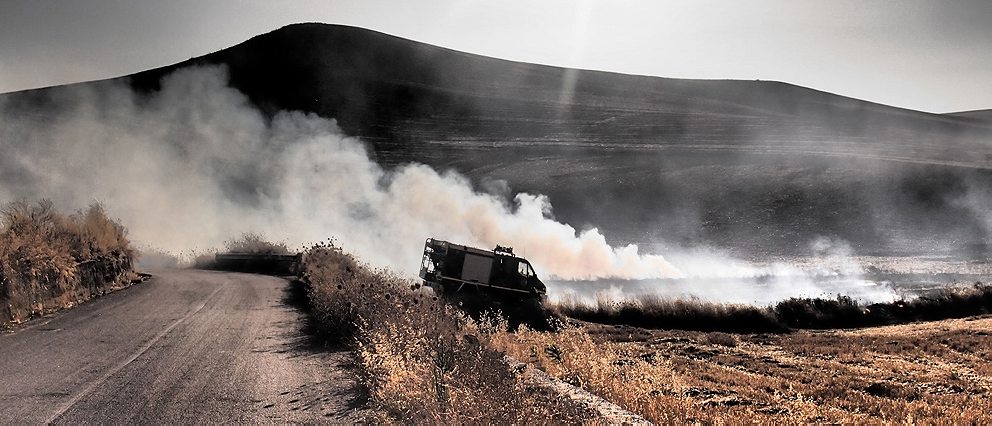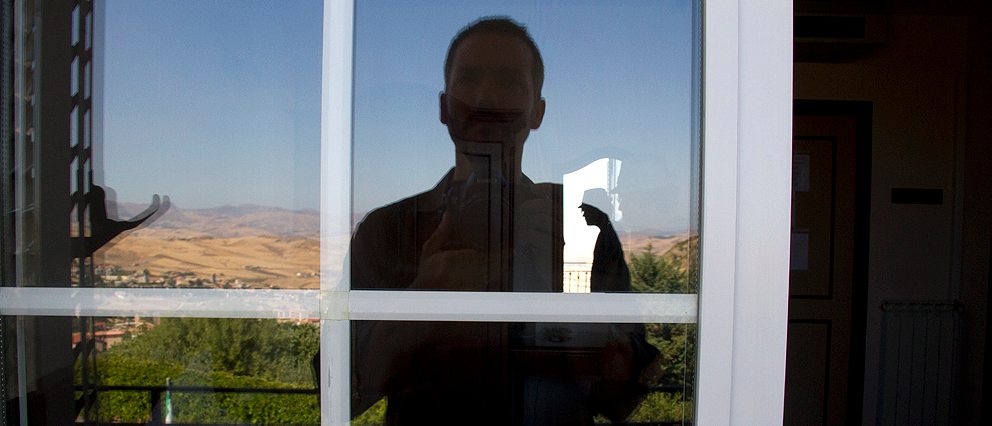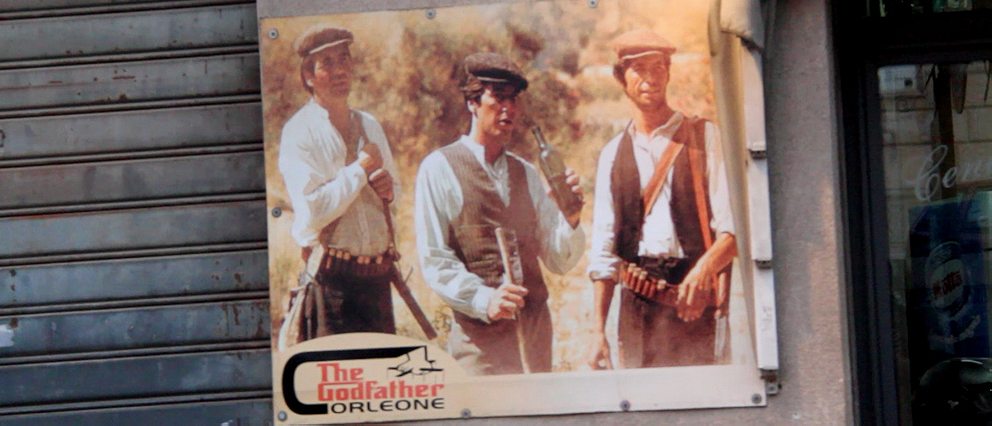Corleone, still trading on the fictions of the Godfather series, was nonetheless home to a very real, very murderous mafia. Plus: just two hotels,
one of them quite shitty. R&K’s Sicily trip continues.
The Road In
Before you arrive in Corleone, if you come up from the south, you reach rolling hills of vineyards and olive orchards, shepherds tending their sheep, and you are so enthralled by the sight and by your own memory of the Godfather trilogy that you forget to be disappointed that the shepherds these days are more likely to be sexting their girlfriends in town than drinking wine from a skein with a rifle slung across their backs.
Then, a turn, and the whole landscape is on fire. It’s the season for burns, for turning over the spent soil by lighting fire to the dry brush, but it’s also the driest season on a dry island—have you seen a cloud yet in Sicily?—and some of those fires burn out of control. If there were more tinder out here besides low grass and dead vines and stone huts on the hilltops, this might be a problem, but in Corleone Country, fire doesn’t burn wildly, it just smolders with Sicilian contempt.
The firetruck passes you on the road and bounces along a path. The firemen get out or lean out of the window and chat with the farmer, who is there with his own truck, and they watch it burn.

Two hours later, on the mountain pass beyond Corleone, overlooking the valley, you’ve stopped in front of the Church of Santa Maria del Malpasso. The church, with its twilight name and the full-moon rising behind it, seems more like a chapel for werewolves than Christians.
Two weeks ago someone had scrawled graffiti here calling for the release of Corleone’s imprisoned mob bosses, a thought crime that had made headlines throughout Sicily.
The words have been erased, but the church still stands malevolent and alone. You turn around to face the south again, and there, in distance, below the sunset, the fires burn on.

A Disagreement
Walter looks like a surfer, or at least an Australian, shaggy blond hair and a reddish beard. But he is not just from Italy, he is from the southern outpost of Italy, Sicily. And he is not just Sicilian, he is from Corleone, the heart of the Sicily of the collective imagination, the land of dry olive groves and rolling hills and crumbling villas and, until not long ago, home to the worst of the mafia.
Sabrina looks more classically Sicilian, though she grew up in the north of Italy. Her family still calls this place home, as all Sicilians who have left for everywhere still do.
Sabrina and Walter disagree, and the disagreement is over this statement: Sicilians are, deep down, proud of the mafia.
Walter, who works for an anti-Mafia foundation in Corleone, makes a persuasive argument. Certainly the museum where he’s a docent does a fine job of showing the children and the women and the innocent who died by the mafia’s hand. It shows the killers for the honorless men they were.
Walter also makes trenchant observations about, for example, the corruption of the campaign in which shopkeepers were putting stickers in their windows declaring that they don’t pay the pizzo, the mafia protection money. Walter says immediately the mafia encouraged stores who were paying protection money to put those mafia-free stickers in their windows themselves to confuse the campaign. Sounds clever, amoral, spiteful: totally plausible from the mafia.
But Walter says other things that seemingly can’t be true, like saying that the mafia is completely gone from Corleone.
Sabrina wouldn’t know much about Corleone—her family is from Ribera, to the south—but she found great truth in other things we had been told throughout Sicily—that the Mafia is not just a family or a group of large men in baggy suits, but rather a mentality, a southern mindset that prevents towns from getting running water, that causes trash strikes, that defends the brokenness of the status quo, that takes a cut from everything and everyone and yet is complained about by few, because so many are complicit in their minor ways. Where it arises, this Sicilian lack of ambition, their reflexive reaction against modernity: this is also mafia.
And, Sabrina says, Sicilians are proud of this. Especially now that they horrid bombings of the early 90s are memory, replaced by fleet-fingered economic crimes. Though Walter would not phrase it the same way, the two Sicilians might agree on this: mafia has been on this island for so long now that the line between mafia and not-mafia is blurry. And Sicilians, who are rightly mad with love for their remarkable island, find themselves having to be proud of mafia on some level. It is their power, their fame, their culture.

An Offer You Can’t Refuse
“We’ve made you a special price.” Six words you never want to hear while on the road. It’s a warning for a grim experience to come.
But you have no option; Corleone isn’t the touristy town you expected it to be. There are just two hotels to be found and the first one is fully booked. But the website description is promising: there is a “deep green garden”, a disco (summers and winters), and a place to play soccer in the back parking lot. All together, the website announces, “Hotel Belvedere is the ideal place in order to find alternative itineraries of the suggestive Sicilian hinterland.”
Sometimes you eat the bear, sometimes the bear eats you. At the Belvedere, the bear chews you up pretty good. The shower clogs and gurgles up through the bidet. The bed groans under the weight of your pasta-bloated body. At the bar downstairs, you taste Sicily’s only bad cappuccino, a sweet, vaguely caffeinated substance that recalls a pit stop in an American gas station.
The credit card machine no longer works and the “special price” turns out to be 100€, as much as you’ve paid for anything the entire trip. In Sicily, 100€ can get you a lot of things: a case of Nero D’Avola, the island’s greatest red wine; a two-bedroom apartment in the center of Palermo; dinner for 6 with wine, coffee and dessert. It can also get you one night at one of the most disappointing hotels in Europe.
When the owner finds out we’re leaving, he seems genuinely sad that we haven’t planned more days at the Belvedere. “Visitors only have a bite and then they leave. Because they’re only interested in the mafia. There’s more to Corleone than the mafia.”

Il Padrino
Vito Andolini was born on December 7, 1891, in a small village an hour south of Palermo known for its connection to organized crime. When his father refused to pay homage to the local don, he was killed. Vito’s brother Paolo swore revenge, but was gunned down before he could dole it out. His mother went to the don to ask that her youngest son be spared, but she too was murdered.
With the don’s men closing in on him, young Vito escaped to America, smuggled out of town and put on a cargo ship packed full of immigrants headed for New York. The administrators at Ellis Island confused his hometown for his last name, and so when emerged on the streets of New York’s Lower East Side, he was now known as Vito Corleone.
Vito eventually became a low-level street hustler, an olive oil importer, and finally the leader of the Corleone crime syndicate, the most powerful mafia family in the United States. With his status secured in the States, Vito returned to his hometown, to the villa where he watched his mother die, and calmly carves a hole in the man who murdered his entire family. By the time he died peacefully among his tomato vines on Long Island, he was known only as the Godfather.
Of course, all of this is fictional, the creation of Mario Puzo, the interpretation of Francis Ford Coppola, and the obsession of cineaphiles, mafia nerds and real life mobsters the world over. But as it turns out, this is a tale of fiction wrapped in fiction, because the Corleone of Coppola’s films was not the Corleone of central Sicily. Those fields where a young Michael wanders with his bodyguards and first comes upon the town that gave him his name? Those are the seaside hills just outside of Taormina on the west coast of Sicily. The bar where he announces his intention of marrying Apollonia, the young beauty from Corleone? Bar Vitelli in Savoca, where the owner María, present for the original filming, still serves cheap local wine today. The villa where Michael’s car is blown up? The town of Fiumefreddo, in the shadow of Mount Etna—three hours by car from the real Corleone.
The real town turned out to be too developed in the 1970s to imitate the Corleone that Coppola wanted to portray in his films. Still, the residue of the Godfather is everywhere you turn. Posters signed by Pacino line the walls of a local bar. The town’s one souvenir shop sells shirts with puppet strings and Marlon Brando lighters. And if you ask a local where to find the church where Michael married Apollonia, he’ll look up from his chair towards the steps just behind you and say: “Here!”
